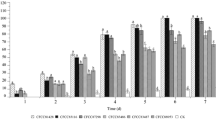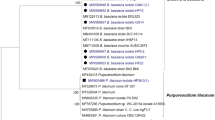Abstract
The gray tiger longicorn beetle, Xylotrechus rusticus Linnaeus (Coleoptera: Cerambycidae) is a stem-boring pest that can inhibit not only the transportation of nutrients in the trunk but also the tree growth, increasing the risk of tree breakage and causing economic losses. It is distributed in China, Iran, Turkey, Russia, Korea, Japan, and Southern Europe. This study aimed to investigate selected Beauveria strains that could be used as entomopathogenic fungi for the biological control of this pest. The high-virulence strains were screened among the selected strains by cumulative mortality, correct mortality, and lethal time to 50% mortality (LT50). These screened high-virulence strains were Bb01, CFCC83486, and CFCC81428. Bb01 exhibited 96.96% cumulative mortality, with an estimated LT50 of 3.28 days. CFCC83486 and CFCC81428 caused 89.29% and 75.74% cumulative mortality, with an estimated LT50 of 3.45 and 4.28 days, respectively. Pathogenicity at different concentrations and lethal concentration of 50% (LC50) of these high-virulence strains were investigated. The pathogenicity was found to be positively correlated with suspension concentration, and LC50 was negatively correlated with infection time. These suspensions of high-virulence strains at different concentrations were also investigated in the forest by brushing the suspensions on the poplar tree trunk infested with X. rusticus L. larvae. The most effective strain was found to be Bb01, whose cumulative mortality reached 76.33% at 1.32 × 108 conidia mL−1, followed by the strain CFCC83486, whose cumulative mortality reached 65.17% at 1.32 × 108 conidia mL−1. This study provides an important basis for using B. bassiana in the biological control of X. rusticus L.




Similar content being viewed by others
References
Brabbs T, Collins D, Hérard F, Maspero M, Eyre D (2015) Prospects for the use of biological control agents against Anoplophora in Europe. Pest Manag Sci 71(1):7–14
Cabanillas HE, Jones WA (2009) Pathogenicity of Isaria, sp. (Hypocreales: Clavicipitaceae) against the sweet potato whitefly B biotype, Bemisia tabaci, (Hemiptera: Aleyrodidae). Crop Protection 28(4):333–337
Cabanillas HE, León JHD, Humber RA, Murray KD, Jones WA (2013) Isaria poprawskii, sp. nov. (Hypocreales: Cordycipitaceae), a new entomopathogenic fungus from Texas affecting sweet potato whitefly. Mycoscience 54(2):158–169
Cao QJ, Chi DF (2017) Screening of high virulent entomopathogenic fungal strains to infect larvae of Cryptorrhynchus lapathi (Coleoptera: Curculionidae). Sci Silvae Sin 53(1):119–127
Castrillo LA, Griggs MH, Vandenberg JD (2016) Competition between biological control fungi and fungal symbionts of ambrosia beetles Xylosandrus crassiusculus and X. germanus (Coleoptera: Curculionidae): mycelial interactions and impact on beetle brood production. Biol Control 103:138–146
Cherry AJ, Abalo K, Hell K, Korie S (2007) Farm-scale trials to compare the entomopathogenic fungus Beauveria bassiana with pirimiphos methyl + deltamethrin and essential oil of lemon grass for protection of stored cowpea against Callosobruchus maculatus (Coleoptera: Bruchidae). Ann Appl Biol 151(1):1–10
Clarkson JM, Charnley AK (1996) New insights into the mechanisms of fungal pathogenesis in insects. Trends Microbiol 4(5):197–203
Ding JN, Zhang HH, Chi DF (2015) Effects of a Pathogenic Beauveria bassiana (Hypocreales: Cordycipitaceae) Strain on Detoxifying and Protective Enzyme Activities in X. rusticus (Coleoptera: Cerambycidae) larvae. Florida Entomol 98(4):1148–1156
Ding JN, Yu J, Chi DF (2016) Study on the biocontrol of Xylotrechus rusticus L. by parasitic enemies. J Nanjing For Univ (Nat Sci Edn) 40(4):107–112
Dubois T, Li Z, Hu JF, Hajek AE (2004) Efficacy of fiber bands impregnated with Beauveria brongniartii cultures against the Asian longhorned beetle, Anoplophora glabripennis (Coleoptera: Cerambycidae). Biol Control 31(3):320–328
Gu LQ, Li CX, Zhang SH (2009) Indoor toxicity test of Beauveria bassiana and Beauveria brongniartii to Spodoptera exigua Hiibner. Jiangsu Agric Sci 41(3):118–120
Guillebeau LP (1994) Risk-benefit analysis of pesticides: the US Environmental Protection Agency perspective. Am Entomol 40(3):173–179
He YR, Lu LH, Kuang ZB, Feng X, Chen HY, Wu YJ (2005) Effect of temperature and humidity on the virulence of beetle-derived Beauveria bassiana (Balsamo) Vuillemin (Deuteromycetes: Moniliales) against the daikon leaf beetle, Phaedon brassicae Baly (Coleoptera: Chrysomelidae). Acta Entomol Sin 48(5):679–686
Hu CX, Huang YH, Li CJ, Sun JH (2004) Larval spatial distribution pattern of Xylotechus rusticus. Entomol Knowl 41(3):241–244
Hu JF, Miao K, Dong ZH, Han B, Fan MZ, Li ZZ (2006) Field trial of application of Beauveria bassiana against Monochamus alternatus. J Anhui Agric Univ 33(3):332–336
Latge JP, Sampedro L, Brey P, Diaquin M (1987) Aggressiveness of Conidiobolus obscurus against the pea aphid: influence of cuticular extracts on ballistospore germination of aggressive and non-aggressive strains. Microbiology 133(7):1987–1997
Li HP, Huang DZ, Wang ZG, Yan HX, Zheng JW (2007) Screening test of highly virulent strains of entomopathogenic fungi Beauveria bassiana against Apriona germari. Larvae Sci Silvae Sin 43(11):66–71
Li JW, Shi J, Xue Y, Mao HB, Luo YQ (2014) Major physiological adjustments in freezing-tolerant grey tiger longicorn beetle (X.rusticus) during overwintering period. J For Res 25(3):653–659
Popa V, Déziel E, Lavallée R, Bauce E, Guertin C (2012) The complex symbiotic relationships of bark beetles with microorganisms: a potential practical approach for biological control in forestry. Pest Manag Sci 68(7):963–975
Qian JJ, Chi DF, Ding JN (2015) Biological characteristics of Beauveria bassiana Bb01 strain. J Anhui Agric Sci 43(27):374–379
Sabbahi R, Merzouki A, Guertin C (2008) Efficacy of beauveria bassiana (Bals.) Vuill. against the tarnished plant bug, Lygus lineolaris L. in strawberries. J Appl Entomol 132(2):124–134
Su P, Liao XL, Zhang Y, Xue ZJ (2009) Advance in controlling Holotrichia diomphalia by Beauveria bassiana in peanut field. Guangxi Agric Sci 40(4):373–377
Verde GL, Torta L, Mondello V, Caldarella CG, Burruano S, Caleca V (2015) Pathogenicity bioassays of isolates of Beauveria bassiana on Rhynchophorus ferrugineus. Pest Manag Sci 71(2):323–328
Wang ZM, Liu GR (2005) Distribution damage and assessment of forestry quarantine pests in Jilin province. For Pest Dis 24(5):19–21
Wang YL, Yang XS, Tan LJ, Wang LJ (2002) Chemical control methods of Xylotechus rusticus L. For Sci Technol 27(3):26
Wang GC, Zhang WD, Song TT, Chen RY (2003) Huangpu port intercepted Cyrtoclytus capra (Germar) and Xylotrechus rusticus L. Plant Quar 17(2):90
Wen P, Wang H (2010) Harm and control technology of Xylotechus rusticus L.. Min Ying Ke Ji 1:92
Woruba DN, Priest MJ, Dewhurst CF, Gitau CW, Fletcher MJ, Nicol HI, Gurr GM (2014) Entomopathogenic fungi of the oil palm pest, Zophiuma butawengi (Fulgoromorpha: Lophopidae), and potential for use as biological control agents. Aust Entomol 53(3):268–274
Zhang LW, Liu YJ, Yao J, Wang B, Huang B, Li ZZ, Fan MZ, Sun JH (2011) Evaluation of Beauveria bassiana (Hyphomycetes) isolates as potential agents for control of Dendroctonus valens. Insect Sci 18:209–216
Zhao GH (2011) A study on the real value of poplar. Pract For Technol 8:20–22
Acknowledgements
This article was supported by the National Natural Science Foundation of China (NSFC) [Grant number: 31370649].
Author information
Authors and Affiliations
Corresponding author
Ethics declarations
Conflict of interest
No potential conflict of interest was reported by the authors.
Rights and permissions
About this article
Cite this article
Wang, Yc., Chi, Df. Screening of high-virulent entomopathogenic fungal strains to infect Xylotrechus rusticus larvae. 3 Biotech 9, 80 (2019). https://doi.org/10.1007/s13205-019-1602-2
Received:
Accepted:
Published:
DOI: https://doi.org/10.1007/s13205-019-1602-2




